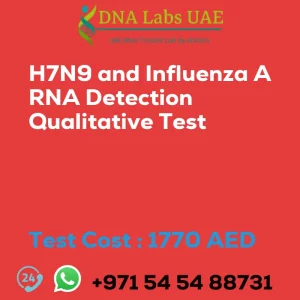H3N2 and Influenza Group A RNA Detection Qualitative Test
Test Name: H3N2 and Influenza Group A RNA Detection Qualitative Test
Components: Nasal swab, nasopharyngeal swab, nasopharyngeal aspirate, throat or bronchial aspirate
Price: 1870.0 AED
Sample Condition: Deep nostrils (nasal swab), nasopharynx (nasopharyngeal swab), nasopharyngeal aspirate, throat or bronchial aspirate
Report Delivery: 3rd Working Day (Email: 36 hours, On phone: 24 hours)
Method: Real Time PCR
Test Type: Viral
Doctor: Physician
Test Department: Genetics
Pre Test Information: Need to sign Consent document and bring any clinical history of patient for H3N2 & Influenza Group A (RNA Detection) Qualitative Test
Test Details
The H3N2 & Influenza Group A (RNA Detection) Qualitative Test is a diagnostic test used to detect the presence of H3N2 and Influenza Group A viruses in a patient’s respiratory sample. This test specifically detects the viral RNA (genetic material) of these viruses.
The test is typically performed using a respiratory sample, such as a nasal swab or throat swab, collected from the patient. The sample is then processed in a laboratory to extract the RNA from the viruses present.
The extracted RNA is then amplified and detected using a technique called reverse transcription polymerase chain reaction (RT-PCR). During RT-PCR, the viral RNA is converted into complementary DNA (cDNA) using reverse transcriptase enzyme. The cDNA is then amplified using PCR, which produces millions of copies of the viral genetic material.
If the H3N2 or Influenza Group A virus is present in the sample, the test will detect and amplify the corresponding viral RNA. The amplified viral RNA is then detected using fluorescent probes that bind specifically to the viral genetic material.
The presence of fluorescence indicates a positive result, meaning that the patient is infected with either H3N2 or Influenza Group A virus. If no fluorescence is observed, it indicates a negative result, meaning that the patient is not infected with these viruses.
This test is highly sensitive and specific, allowing for accurate and reliable detection of H3N2 and Influenza Group A viruses. It is commonly used in clinical settings, especially during flu seasons, to diagnose and monitor the spread of these viruses.
| Test Name | H3N2 and Influenza Group A RNA Detection Qualitative Test |
|---|---|
| Components | |
| Price | 1870.0 AED |
| Sample Condition | Deep nostrils (nasal swab), nasopharynx (nasopharyngeal swab), nasopharyngeal aspirate, throat or bronchial aspirate. |
| Report Delivery | 3rd Working Day Email:-36 hours.On phone: 24 hours |
| Method | Real Time PCR |
| Test type | Viral |
| Doctor | Physician |
| Test Department: | Genetics |
| Pre Test Information | Need to sign Consent document and bring any clinical history of patient forH3N2 & Influenza Group A (RNA Detection) QualitativeTest |
| Test Details |
The H3N2 & Influenza Group A (RNA Detection) Qualitative Test is a diagnostic test used to detect the presence of H3N2 and Influenza Group A viruses in a patient’s respiratory sample. This test specifically detects the viral RNA (genetic material) of these viruses. The test is typically performed using a respiratory sample, such as a nasal swab or throat swab, collected from the patient. The sample is then processed in a laboratory to extract the RNA from the viruses present. The extracted RNA is then amplified and detected using a technique called reverse transcription polymerase chain reaction (RT-PCR). During RT-PCR, the viral RNA is converted into complementary DNA (cDNA) using reverse transcriptase enzyme. The cDNA is then amplified using PCR, which produces millions of copies of the viral genetic material. If the H3N2 or Influenza Group A virus is present in the sample, the test will detect and amplify the corresponding viral RNA. The amplified viral RNA is then detected using fluorescent probes that bind specifically to the viral genetic material. The presence of fluorescence indicates a positive result, meaning that the patient is infected with either H3N2 or Influenza Group A virus. If no fluorescence is observed, it indicates a negative result, meaning that the patient is not infected with these viruses. This test is highly sensitive and specific, allowing for accurate and reliable detection of H3N2 and Influenza Group A viruses. It is commonly used in clinical settings, especially during flu seasons, to diagnose and monitor the spread of these viruses. |








